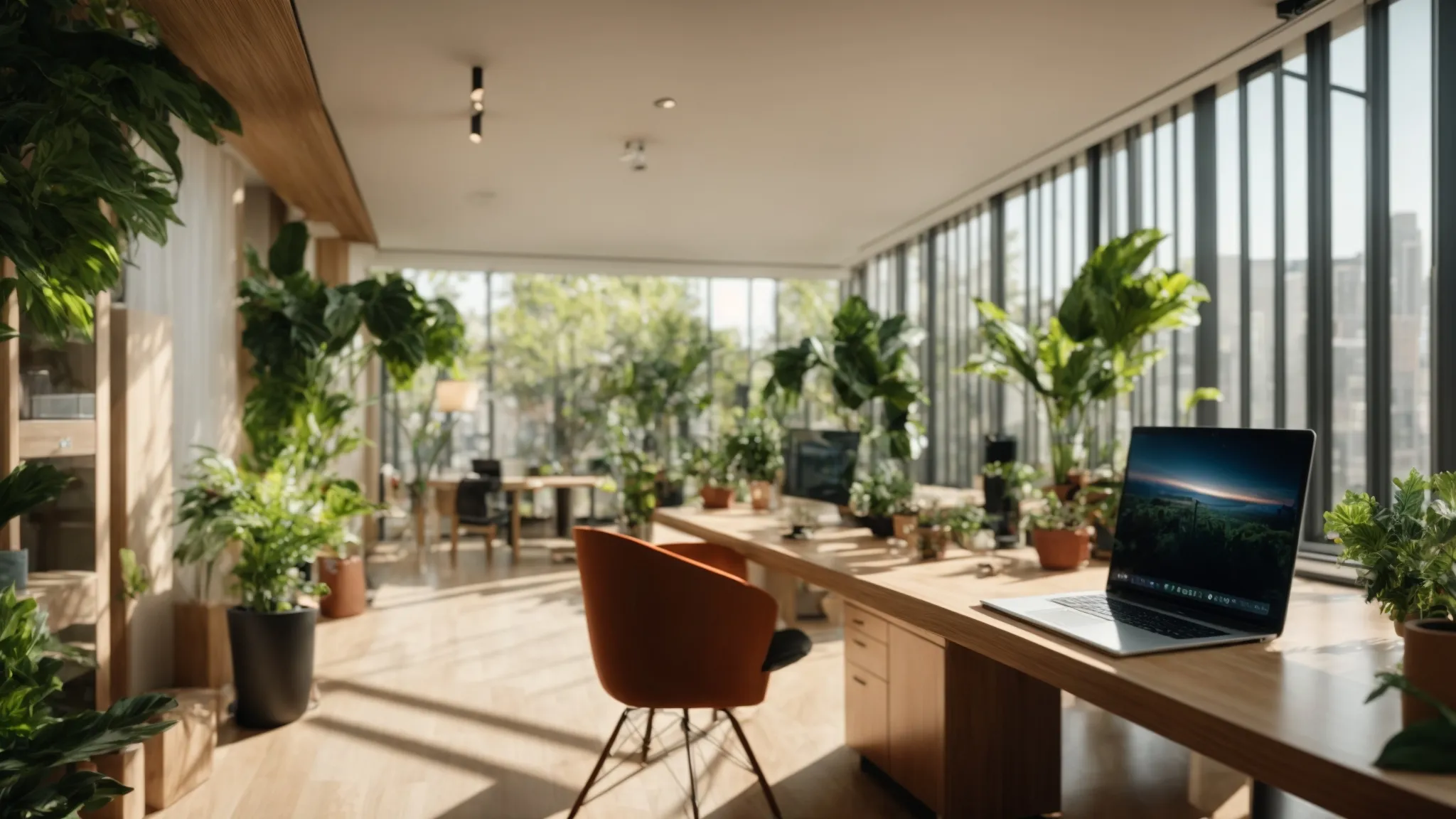Heads Up: When you purchase through links on our site, we may earn an affiliate commission at no cost to you.
To design the perfect home search page, you need to ensure it does two jobs: it helps visitors find the right listings fast and it shows your brand runs a clean, modern operation. It’s the first place people judge speed, accuracy, and trust—often in seconds.
Build around clarity and performance. Give users precise filters (price, beds, neighborhoods), a smooth map + list view, saved searches with instant alerts, real photos, and quick ways to call, text, or book a tour. Keep it lightweight on mobile and sharp on desktop.
In this guide, you’ll learn how to design the perfect home search page—covering layout, navigation, usability, mobile responsiveness, and on-page SEO. By the end, you’ll know how to use color, typography, structured sections, and smart filters to create a fast, high-converting search experience.
Key Takeaways
- User experience (UX) and intuitive navigation are essential for designing a high-converting home search page.
- AI-powered personalization, predictive search filters, and automated recommendations improve lead generation and buyer engagement.
- SEO optimization, structured metadata, and search engine-friendly design increase organic search rankings and visibility.
- Mobile responsiveness, fast-loading pages, and interactive property listings enhance usability across all devices.
- Strong branding, call-to-action (CTA) buttons, and social proof elements establish credibility and trust with potential buyers.
- AI-driven analytics, real-time tracking, and automated lead scoring ensure continuous optimization and conversion improvements.
- Future advancements in AI, augmented reality (AR), and machine learning will shape next-generation home search platforms.
Key Elements of an Effective Home Search Page

Your search page should feel obvious, fast, and action-ready—clear filters, quick results, and next steps that are hard to miss.
Simple and Intuitive Website Navigation
Put the essentials above the fold: keyword search, price, beds/baths, neighborhoods, and a map + list toggle. Labels should match how buyers talk (“Price,” “Beds,” “Neighborhoods”), not internal jargon. Keep the header clean, use sticky filters, and show total results as users adjust options.
Make movement effortless. Add sorting (newest, price, days on market), breadcrumbs, and a visible “clear all.” Persist choices while users flip between map and list so they don’t have to redo work. On mobile, collapse filters into a slide-in drawer with large tap targets and a “view results” button that stays on screen.
Guide people toward action. Place “Save search,” “Get alerts,” “Book a tour,” and “Text an agent” near the results. After a filter change, update counts instantly to confirm progress. Small helper text—“Now showing homes in Eastlake under $600k”—reduces confusion and raises clicks.
Importance of SEO for Home Search Pages
Treat the page like a high-intent landing experience. Use a concise title tag and H1 that pair your market with “home search.” Add a clear meta description, compress images, and write descriptive alt text for maps and thumbnails. Internal links to city and neighborhood pages help distribute authority.
Control crawl paths so filters don’t create index bloat. Use clean, human-readable URLs for core areas, then manage faceted variants with canonical tags and noindex where appropriate. Surface only valuable combinations (e.g., “City + Neighborhood” pages) in your sitemap; keep sort orders out of the index.
Relevance and speed go hand in hand. Preload critical assets, lazy-load listing images, and cap initial cards per page to cut Largest Contentful Paint. Add LocalBusiness/Organization and BreadcrumbList schema on the template, and link prominently to your contact page and bio to support brand queries and conversions.
- Instant feedback
- Valuable insights
- Actionable tips
Aesthetically Pleasing and Functional Design

Great design should look clean and feel easy. It should guide the eye, load fast, and work well on phones and desktops.
Creating a Visually Engaging and User-Friendly Experience
Start with a simple layout. Put the search box and core filters up top, then show results right away. Use clear headings, plenty of white space, and short lines so people can scan fast.
Next, make key actions stand out. Buttons like “Save search,” “Get alerts,” and “Book a tour” should be large and easy to spot. Use contrast and consistent placement so users don’t have to hunt.
Finally, keep text readable. Pick a clean font, generous size, and steady line spacing. Add small hints under filters (for example, “Homes under ₱5M in Davao”) so visitors know exactly what they’re seeing.
Integrating High-Quality Media and Interactive Features
Lead with real, sharp photos. Show the main image first, then add a quick gallery. However, compress files so pages load quickly, and lazy-load the rest after the first screen.
Then add simple tools that help decisions. A map + list toggle, quick-view cards, and a compare button keep users moving. Short video tours are great, but keep them light so mobile users aren’t stuck waiting.
Close with clear captions. Describe each image in plain words and tag it with the area or landmark. This helps users understand the home at a glance and supports search.
Brand Consistency and Trust Through Design
Keep your brand steady across the page. Use the same colors, button styles, and tone everywhere. Place your logo and contact options where users expect them—top bar and footer.
Also, show proof near the top. Add a short review, a recent win, or a badge (years in business, local award). Small trust cues calm doubts and nudge clicks.
Lastly, be transparent. List brokerage details, license info, and fair-housing text. Repeat your main CTA in the header and near the end so visitors always know how to reach you.
Search Engine Optimization and Visibility

Treat your search page like a high-intent landing page. Keep it clear, fast, and easy to crawl so people find it and take action.
Maximizing Home Search Page Rankings with SEO Best Practices
First, set the basics. Write a clear title tag with your market, a matching H1, and a short meta description that promises value. Then, add internal links to top city and neighborhood pages so users have simple next steps.
Next, structure the page for scanners. Use short paragraphs, plain headings, and clean URLs. Add helpful copy above the listings that names the area, price bands, and property types. This gives search engines context without stuffing keywords.
Finally, layer in proof. Link to reviews, your bio page, and contact options. Add Person and LocalBusiness schema where allowed. This helps search engines confirm who you are and improves clicks from brand searches.
Technical SEO for Faster Load Times and Mobile Optimization
Start with speed. Compress images, lazy-load galleries, and cap how many listing cards load on the first paint. Also, serve static assets from a CDN and preconnect to needed domains.
Then, protect Core Web Vitals. Keep Largest Contentful Paint low with light hero sections. Reduce layout shift by setting image sizes. Improve interaction by avoiding heavy scripts on page load.
Lastly, make mobile first. Use large tap targets, a slide-in filter drawer, and a sticky “View results” button. Test on real phones, slow networks, and low-end devices. If something feels slow, trim it.
Local SEO for Targeting Homebuyers in Specific Markets
Begin with clear location signals. Mention the city, key neighborhoods, schools, and nearby landmarks in plain text. Add internal links to those area pages so users can dig deeper.
Next, align with your Google Business Profile. Match NAP details, link the bio page, and embed a simple map on contact pages (not on every listing page). Ask for recent reviews and feature one or two short quotes on the search page footer.
Finally, create a few smart landing variants. Build static pages for “City + Neighborhood” searches with helpful copy and a filtered listings module. Avoid indexing endless filter combos; instead, focus on pages that people actually search for.
Enhancing User Experience for Higher Engagement

Make the search easy, fast, and clear. Small tweaks to mobile layout, smart filters, and media can lift clicks and leads.
Creating a Mobile-Friendly Home Search Page
First, design for phones. Put the search bar and core filters at the top. Use a slide-in filter panel with large tap targets and a sticky “View results” button, so people can change options without losing their place. Keep forms short and autofill common fields to speed things up.
Next, cut load time. Compress photos, lazy-load galleries, and limit how many cards show at first. Preload the next set as users scroll. This keeps pages snappy on slow data and older devices.
Finally, make actions obvious. Keep “Save search,” “Get alerts,” and “Book a tour” in the same spot on every screen size. Show a clear success message after each tap. This reduces confusion and boosts follow-through.
Personalization and AI-Driven Search Filters
Start with simple saves. Let visitors store searches and favorite homes in one tap. Then send instant alerts for price drops, new matches, and open houses. These alerts bring people back without extra ad spend.
Next, guide choices. Suggest nearby areas, similar homes, and price bands based on past clicks. Add quick toggles like “new this week” or “with parking.” Helpful nudges cut time to the right list.
Finally, sync with your CRM. Push saved searches, tags, and favorites into contact records. Then trigger fast, relevant follow-ups. For example, send two close comps and offer three showing times. This turns interest into real conversations.
Engaging Visual Content and Interactive Features
First, lead with clear media. Use sharp cover photos, clean captions, and short clips under 30 seconds. Show the kitchen, living area, and exterior first. People decide fast, so put the best angles up front.
Next, add light interactivity. Offer a map + list toggle, quick-view cards, and a compare tool. Keep 3D tours and videos optional, and load them only on tap. This keeps speed high while giving depth on demand.
Finally, keep context close. Add badges like “new,” “price cut,” or “open house Sat.” Include school zones, travel times, and walk times where helpful. These small cues answer common questions and move users to book a tour.
Boosting Credibility and Trust Through Design

Your search page should turn interest into action. Keep steps short, buttons clear, and choices simple.
Clear Calls-to-Action That Stand Out
First, place primary CTAs where eyes land. Put “Book a tour,” “Text an agent,” and “Save search” above the fold and repeat them after the first screen of results. On mobile, keep a sticky bar with one main action so users never hunt.
Next, write plain labels. Say “Book a tour” instead of “Submit.” Add a short promise under the button like “Reply in under an hour.” Simple words set clear expectations and raise clicks.
Finally, keep design steady. Use one color for primary actions and one for secondary. Keep size and placement the same on every screen. This builds habit and speeds decisions.
Form Design That Reduces Friction
Start with fewer fields. Ask for name, email, and phone only. Let users add notes later. Each extra field costs leads, so keep the first step light.
Then, help users finish. Offer autofill, show inline tips, and validate fields as they type. If spam is a worry, use an invisible CAPTCHA or a honeypot so real people are not slowed down. For deeper form tips, see Nielsen Norman Group’s guidance on form design (helpful, research-based best practices).
Lastly, connect the form to your flow. Send a clear success message, create a task for the agent, and send a quick confirmation by email or text. Small, fast signals build trust and keep people engaged.
Saved Searches, Alerts, and Soft Conversions
First, offer one-tap saves. Let visitors favorite homes and save searches without a long signup. Then ask for email or phone to turn on alerts. Light steps bring more people into your list.
Next, make alerts useful. Send new matches, price drops, and open-house times. Keep messages short and link back to the exact results, not a generic page. This brings users back without more ads.
Finally, add soft CTAs for shy buyers. “Email this listing,” “Share with a friend,” or “Ask a quick question” are low-pressure paths that still start a thread. Those threads often turn into tours once trust builds.
Maximizing Lead Generation and Conversion Rates
Your search page should get better each week. Track simple numbers, test small changes, and ship quick fixes.
Track the Right Numbers
Start with a short list. Watch time on page, clicks on “Save search” and “Book a tour,” and how many people reach a listing from search. Also, check mobile load time and bounce rate. These tell you if users find value or get stuck.
Then tie action to sources. Compare results by traffic type—organic, ads, email, and social. If one source brings views but no tours, fix the page users land on or the message that sent them there. Keep the tests focused.
Finally, share the wins. Post a simple weekly note: what moved up, what slipped, and one change you’ll try next. Small cycles keep the team aligned and the page sharp.
A/B Test to Find Easy Wins
First, test high-impact items. Try new button text, CTA order, or where the “Save search” button sits. Change one thing at a time so you know what worked. Keep tests live for enough visits to be sure.
Next, use simple rules. A win is a clear lift in clicks or tours booked, not just “looks nicer.” If the change helps on desktop but hurts on mobile, ship a mobile-only version. Meet users where they are.
Finally, repeat with care. Retest winners every few months. Markets shift and what worked in June may fade by October. For guidance on test basics, Google’s documentation on Core Web Vitals and performance is a solid reference.
Improve With What You Learn
First, fix speed before style. If load time is slow, compress images, lazy-load photos, and trim heavy scripts. A fast page helps every other metric.
Then, adjust content to match demand. If many users filter for one area or price band, feature it higher. If alerts get clicks, make “Get alerts” easier to find. Let user behavior set the roadmap.
Finally, close the loop. Send key events—saved searches, favorites, and tour requests—into your CRM. Then follow up fast with two matching homes and three showing times. That is how testing turns into real calls and signed deals.
Frequently Asked Questions (FAQs)
Why is a well-designed home search page important for real estate websites?
A structured home search page enhances user experience, engagement, and lead generation, ensuring buyers can easily find and filter properties.
How does SEO improve home search page performance?
SEO optimization, keyword research, and metadata enhancements increase search engine rankings, improving organic traffic and visibility for real estate websites.
What role does AI play in home search page design?
AI-driven search filters, personalized property recommendations, and machine learning-powered analytics enhance usability, engagement, and lead conversion rates.
How can realtors optimize their home search pages for mobile users?
Realtors ensure seamless browsing experiences across devices by implementing responsive web design, fast-loading mobile pages, AI-enhanced navigation, and voice search compatibility.
What are the best ways to improve lead generation on a home search page?
Real estate professionals can capture and nurture high-quality leads using AI-driven chatbots, predictive lead scoring, engaging CTAs, and personalized email automation.
Will AI and automation shape the future of real estate home search platforms?
Yes, advancements in AI-driven SEO, voice search, virtual reality property tours, and predictive real estate analytics will continue to transform home search platforms and buyer experiences.
Conclusion
A great home search page feels instant and obvious. Lead with a clear headline, a location/keyword box, and a concise set of high-intent filters (e.g., price, number of beds, property type). Show results fast with large photos, clean pricing, and clear next steps—save search, schedule a tour, ask a question. Keep a map toggle handy, make CTAs sticky on mobile devices, and cache images to keep pages loading quickly. Route every action into your CRM with tags so follow-ups fire without delay.
Turn the page into an engine, not a brochure. Link results to neighborhood and school pages, add breadcrumbs, and track what matters: searches run, filters used, saves, tour requests, and calls. Review this data monthly, move the best modules higher, and trim anything that slows visitors down. Small, steady tweaks compound into more showings and signed agreements.
If you want a conversion-first search page built on your Carrot stack—wireframes, copy, schema, and tracking—you can request a search-experience blueprint and we’ll map a 90-day rollout with clear deliverables and timelines.














